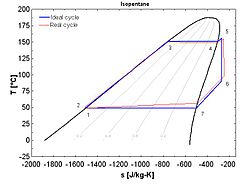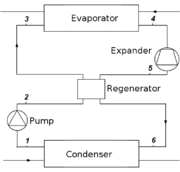- Organic Rankine Cycle
-
The Organic Rankine cycle (ORC) is named for its use of an organic, high molecular mass fluid with a liquid-vapor phase change, or boiling point, occurring at a lower temperature than the water-steam phase change. The fluid allows Rankine cycle heat recovery from lower temperature sources such as biomass combustion, industrial waste heat, geothermal heat, solar ponds etc. The low-temperature heat is converted into useful work, that can itself be converted into electricity. A prototype was first developed and exhibited in 1961 by solar engineers Harry Zvi Tabor and Lucien Bronicki.
Contents
Working principle of the ORC
The working principle of the organic Rankine cycle is the same as that of the Rankine cycle: the working fluid is pumped to a boiler where it is evaporated, passes through a turbine and is finally re-condensed.
In the ideal cycle, the expansion is isentropic and the evaporation and condensation processes are isobaric.
In the real cycle, the presence of irreversibilities lowers the cycle efficiency. Those irreversibilities mainly occur[1] :
- During the expansion: Only a part of the energy recoverable from the pressure difference is transformed into useful work. The other part is converted into heat and is lost. The efficiency of the expander is defined by comparison with an isentropic expansion.
- In the heat exchangers: The working fluid takes a long and sinuous path which ensures good heat exchange but causes pressure drops that lower the amount of power recoverable from the cycle. Likewise, the temperature difference between the heat source/sink and the working fluid generates exergy destruction and reduces the cycle performance.
Improvement of the organic Rankine cycle
In the case of a "dry fluid", the cycle can be improved by the use of a regenerator : since the fluid has not reached the two-phase state at the end of the expansion, its temperature at this point is higher than the condensing temperature. This higher temperature fluid can be used to preheat the liquid before it enters the evaporator.
A counter-current heat exchanger is thus installed between the expander outlet and the evaporator inlet. The power required from the heat source is therefore reduced and the efficiency is increased.
Applications for the ORC
The organic Rankine cycle technology has many possible applications, and counts more than 250 identified power plants worldwide [2] [3]. Among them, the most widespread and promising fields are the following:[4]
- Waste heat recovery
Waste heat recovery is the most important development field for the Organic Rankine Cycle (ORC).[citation needed] It can be applied to heat and power plants (for example a small scale cogeneration plant on a domestic water heater), or to industrial and farming processes such as organic products fermentation, hot exhausts from ovens or furnaces, flue gas condensation, exhaust gases from vehicles, intercooling of a compressor, condenser of a power cycle, etc.[5]
- Biomass power plant
Biomass is available all over the world and can be used for the production of electricity on small to medium size scaled power plants. The problem of high specific investment costs for machinery such as steam boilers are overcome due to the low working pressures in ORC power plants. Another advantage is the long operational life of the machine due to the characteristics of the working fluid, that unlike steam is non eroding and non corroding for valve seats tubing and turbine blades. The ORC process also helps to overcome the relatively small amount of input fuel available in many regions because an efficient ORC power plant is possible for smaller sized plants.
Geothermic heat sources vary in temperature from 50 to 350°C. The ORC is therefore perfectly adapted for this kind of application. However, it is important to keep in mind that for low-temperature geothermal sources (typically less than 100°C), the efficiency is very low and depends strongly on heat sink temperature (defined by the ambient temperature).
The organic Rankine cycle can be used in the solar parabolic trough technology in place of the usual steam Rankine cycle. The ORC allows a lower collector temperature, a better collecting efficiency (reduced ambient losses) and hence the possibility of reducing the size of the solar field.[6]
Choice of the working fluid
The selection of the working fluid is of key importance in low temperature Rankine Cycles. Because of the low temperature, heat transfer inefficiencies are highly prejudicial. These inefficiencies depend very strongly on the thermodynamic characteristics of the fluid and on the operating conditions.
In order to recover low-grade heat, the fluid generally has a lower boiling temperature than water. Refrigerants and hydrocarbons are two commonly used components.
Optimal characteristics of the working fluid :
- Isentropic saturation vapor curve :
Since the purpose of the ORC focuses on the recovery of low grade heat power, a superheated approach like the traditional Rankine cycle is not appropriate. Therefore, a small superheating at the exhaust of the evaporator will always be preferred, which disadvantages "wet" fluids (that are in two-phase state at the end of the expansion). In the case of dry fluids, a regenerator should be used.
- Low freezing point, high stability temperature :
Unlike water, organic fluids usually suffer chemical deteriorations and decomposition at high temperatures. The maximum hot source temperature is thus limited by the chemical stability of the working fluid. The freezing point should be lower than the lowest temperature in the cycle.
- High heat of vaporisation and density :
A fluid with a high latent heat and density will absorb more energy from the source in the evaporator and thus reduce the required flow rate, the size of the facility, and the pump consumption.
- Low environmental impact
The main parameters taken into account are the Ozone depletion potential (ODP) and the global warming potential (GWP).
- Safety
The fluid should be non-corrosive, non-flammable, and non-toxic. The ASHRAE safety classification of refrigerants can be used as an indicator of the fluid dangerousness level.
- Good availability and low cost
- Acceptable pressures
See also
- Rankine cycle
- Thermodynamic cycle
- Relative cost of electricity generated by different sources
Thermodynamic cycles External combustion cycles Bell Coleman · Brayton/Joule (externally heated) · Carnot · Ericsson · Ported constant volume[1] · Stirling · Stirling (Pseudo / Adiabatic) · StoddardWith phase changeInternal combustion cycles Mixed cycles Refrigeration cycles Hampson-Linde · Kleemenko · Linde dual-pressure · Pulse tube · Regenerative cooling · Transcritical · Vapor absorption · Vapor-compression · Siemens · VuilleumierUncategorized References
- ^ "Sustainable energy conversion through the use of Organic Rankine Cycles for waste heat recovery and solar applications" (PDF). http://orbi.ulg.ac.be/handle/2268/96436. Retrieved 2011-10-31.
- ^ KGRA Energy. "Worldwide ORC Installations". http://www.kgraenergy.com/projects/worldwide-orc-installations. Retrieved 16 August 2011.
- ^ Enertime. "Current ORC Market". http://www.cycle-organique-rankine.com/marches-constructeurs-reference.php. Retrieved 31 October 2011.
- ^ "Technological and Economical Survey of Organic Rankine Cycle Systems" (PDF). http://orbi.ulg.ac.be/handle/2268/14609. Retrieved 2010-09-15.
- ^ "Design, optimization and modeling of an organic Rankine cycle for waste heat recovery" (PDF). http://www.labothap.ulg.ac.be/cmsms/uploads/File/TFE_SD090623.pdf. Retrieved 2010-09-15.
- ^ "Solar micro-generator". Stginternational.org. http://www.stginternational.org/how-it-works.html. Retrieved 2010-09-15.
Categories:- Thermodynamic cycles
Wikimedia Foundation. 2010.







